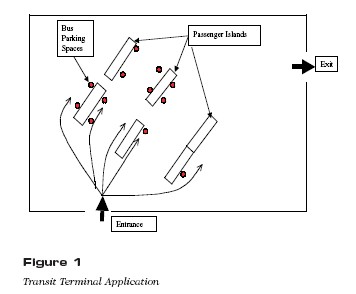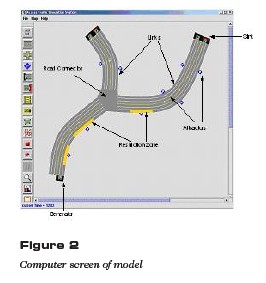|
This project developed a simulation and animation model of traffic flow in bus transit terminals. The model is designed to assist transit facility planners and engineers in testing alternative strategies to improve the efficiency of bus flow, increase capacity, and minimize delays and vehicle emissions in bus transit terminals. The objective of the project was to develop and demonstrate this computerized planning and design tool for increasing the efficiency of vehicular flow in bus transit terminals.
 
Completed Investigation
The investigators (a) developed routines and logic to describe bus vehicle and pedestrian (object) movement; and (b) designed a user-interface for data input and output including background for animation (i.e., layout and editing features). In particular, the elements involving random variables such as vehicle arrival rates, dwell times, and pedestrian/passenger flow, that lead to nonrecurrent congestion were analyzed and defined in relation to the modules they fall into within the overall model. The investigators also incorporated high-performance graphics capabilities to the 2-D simulation and developed predefined 3-D views.
Tests were performed to determine the robustness and validity of the individual modules of the model. The first module, the graphics module, was tested to determine the flexibility of importing and editing site configurations, particularly with regard to changing dimensions and characteristics such as angles of bus bays and no-parking zones. The second module, the traffic/pedestrian flow module, was tested for the accuracy of event generation rates as well as for logic governing object movement. Typical Washington Metropolitan Area Transit Authority (WMATA) transit terminal operations at the Silver Spring Metrorail station bus loading area were used to test the ability of the model to simulate and animate the conditions. An expert review panel, including consultants and WMATA staff, reviewed and commented on the work and the applicability of the model.
WMATA and its planning consultants provided the necessary data and graphical backgrounds for the animation. A literature review of recent advances in traffic and pedestrian simulation principles and technologies was also conducted.
Product Payoff Potential
The tool developed in this project will permit pre- and post-implementation testing of traffic management strategies and layouts for bus transit terminals. It will allow a planner to review the impact of a strategy both visually (queuing, etc.) as well as statistically (average delays, volumes, etc.). Moreover, it will permit plans for new transit terminal facilities to consider traffic/demand conditions.
Product Transfer
The model was made available to WMATA for use in planning and designing future facilities. A final report and a user guide detail the project activities, test design, and results.
The final report for this IDEA project can be found at:
https://onlinepubs.trb.org/onlinepubs/archive/studies/idea/finalreports/transit/Transit32_Final_Report.pdf.
|
|